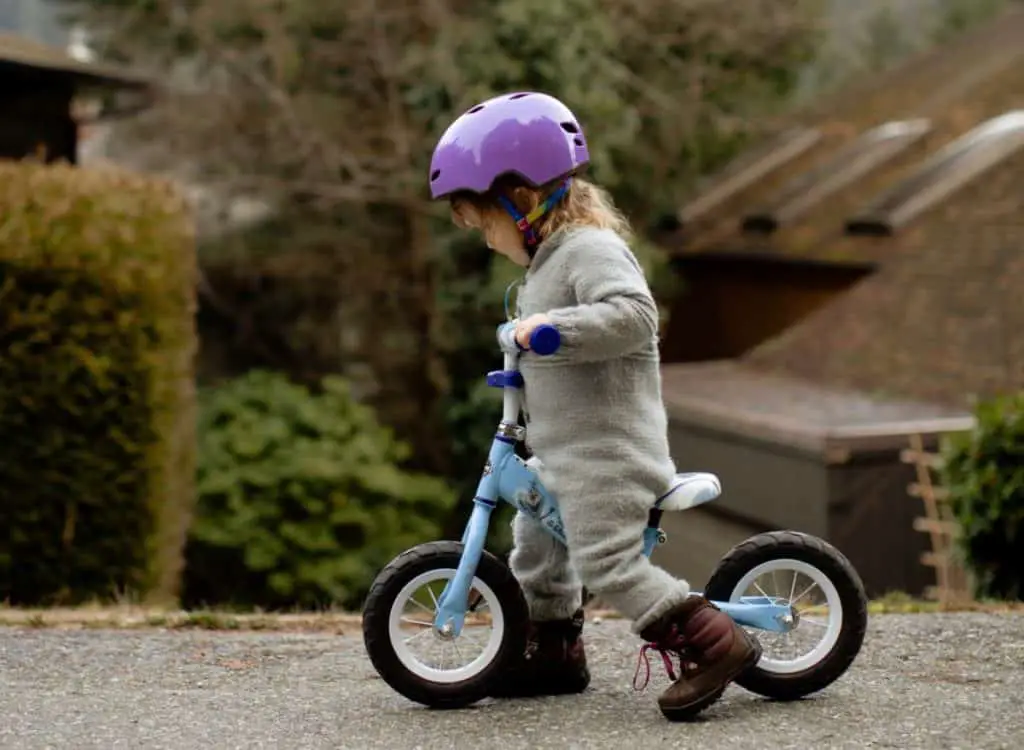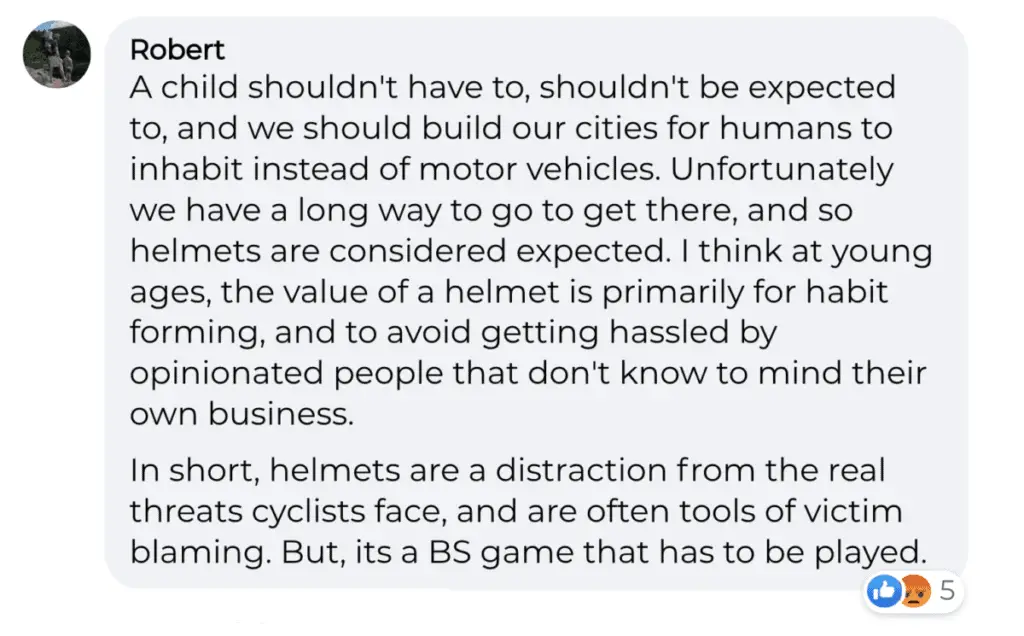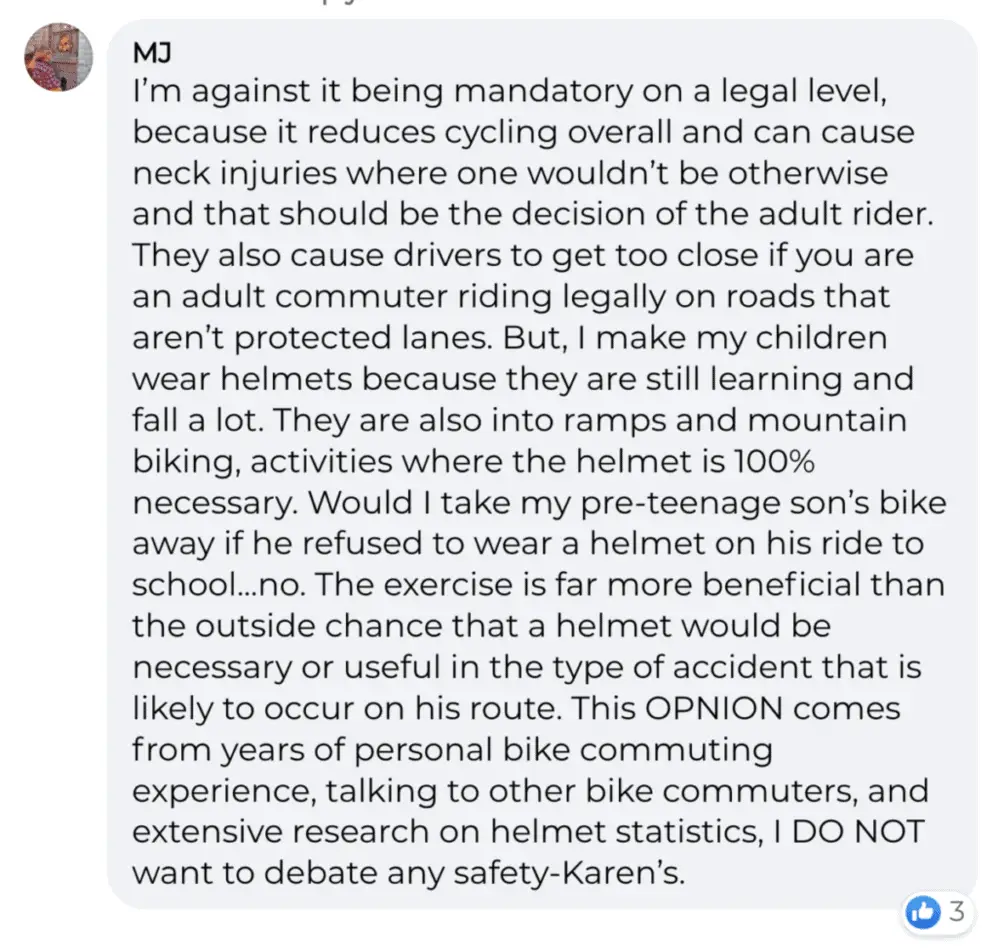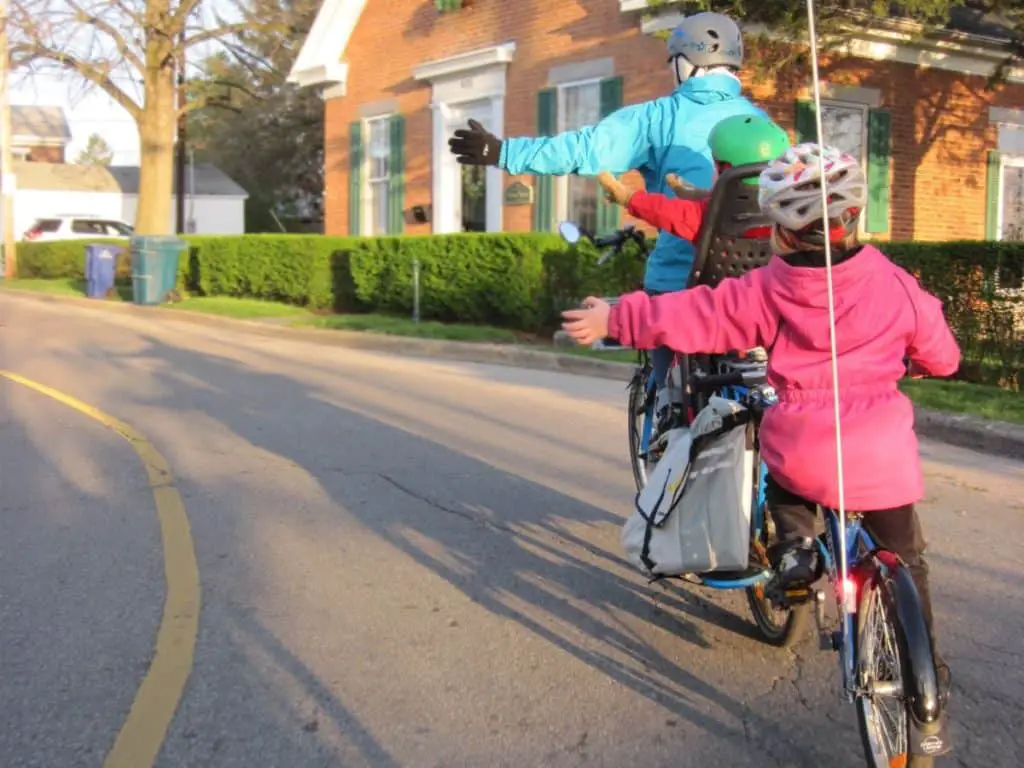Wearing a bike helmet is an accepted practice in the United States and many other countries around the world.
On the surface, it seems to be good practice to protect a child’s head with a helmet in the event of a crash.
Our surveys have shown that 96.7% of parents agree that children should always wear a helmet, but not all parents share that opinion. (We’ll share their responses later in this article).
So should children be required to wear a helmet?
Bicycle helmets on children are required by law in many states in the United States. Some countries that have better biking infrastructure do not require helmets on children, such as the Netherlands. Such countries have significantly fewer fatal biking accidents, and therefore do not prioritize helmets as much as in the United States.
It is usually surprising to some parents to hear that helmets are completely optional in many places around the world. After all, the common rule is “no helmet, no ride” in most American households.
In our survey of parents, many respondents had no idea that other opinions on helmets exist.
However, there are valid reasons that some countries do not encourage or force children to wear helmets, which we will get into below.

The helmet debate: Helmet or no helmet?
The debate on whether helmets should be required is a never-ending can of worms. Governments attempt to reduce the risks of fatalities by mandating that all cyclists wear helmets, while at the same time there is evidence to show that making it mandatory reduces the appeal of riding a bike overall.
It seems harmless and reasonable on the surface to make helmets required, but if you dig deeper into the studies on the risks of cycling, you find that there is evidence that shows that people are much less likely to choose to ride a bike if they are required to wear a helmet. In other words, it’s an inconvenience.
In places that place high importance on biking instead of driving, like Japan and the Netherlands, it is actually very rare to find people wearing helmets. And they do not have high rates of head injuries. In fact, it is even difficult to find helmets in those countries.
So the argument becomes that it’s not cycling that is dangerous—it’s riding around cars that pose the greatest risk. So with that logic, people who are walking or jogging next to traffic should also wear helmets.
As you can see, the debate is heated across the cycling community. I’ll offer my experience talking with many parents from different countries about this issue.
My experience riding with kids in the US, Japan, and Europe
As someone who has ridden extensively in the United States, Japan, and Europe, and heard all sides of the helmet debate, here is my conclusion: It comes down to how developed a country is around cycling.
1. The United States is still not bike-friendly, so it’s better for children to wear helmets
The current infrastructure and culture around cycling in the United States is still quite dangerous for children. There are very few cities like Minnesota and Boulder where children can freely ride on bike-only greenways to get around town. In most of the United States, children would need to either ride on the road or cross busy streets in order to get where they need to go.
We have a long way to go before the US achieves infrastructure standards like the Netherlands, so helmets are still necessary in the United States as a whole.
However, as cycling becomes more prominent and drivers become more aware of their presence, the infrastructure will further develop and car-related fatalities will be fewer.
2. Countries that are built around cycling culture don’t need helmets as much
Countries that have a cycling culture do not have as many bike-related fatalities in relation to the number of people cycling every day. As more people choose to ride a bike rather than drive, helmet resources become more scarce.
When I first started riding in Japan with my kids, I was initially surprised by how difficult it was to even find helmets for them. I had to go to multiple large outlet stores just to find two little helmets that didn’t even fit them. Then I realized that virtually every child in Japan does NOT wear a helmet. How do they do it? Education. They educate children and drivers very well on how to be respectful and safe on the rode.
The no-helmet culture works in some countries because they have the education and environment to support it.
3. Children should be educated to be aware of cyclists and protect themselves
Education is the best alternative, even better than strictly enforcing the helmet law without explaining why. It is important for children to grow up with awareness that there are cyclists on the road and that they should drive and ride responsibly.
In addition, children can be taught from a very young age how to protect themselves while riding. It’s important to learn to bike defensively, regardless of where you live.
We tend to think that children are unable to understand responsibility and safety, but they can learn those qualities even before they learn how to ride a bike. If we just enforce helmet wearing because “it’s the law” without explaining why, then we’re not doing what’s actually most important: Education.

We asked parents: Should a child wear a helmet?
When we surveyed a group of parents, 9.6% stated that children should always wear a helmet. However, the limitation of this survey was that most respondents are from America, where many states require a helmet by law and there is a strong emphasis on wearing a helmet at all times.
The general consensus is that a helmet could save a child’s life, with many parents sharing stories of close encounters.
When asked, “Should a child wear a helmet?” here are some responses.



As you can see, the helmet debate is a hot one!


But not all parents agree that helmets should be required.


Arguments for children to wear a helmet
According to our polls, most American parents across the board agree that children should always wear helmets.
1. A helmet could save a life
Wearing a helmet is the simplest and best line of defense against a possible life-threatening head injury. In the unlikely event of a crash, a protective material surrounding the child’s skull could save them in a deadly situation. Although my children have never come close to experiencing a crash or accident while riding a bike, having the helmet on gives me a little peace of mind if it were to ever happen.
2. Helmets teach children safety precautions
Like wearing a seat belt, wearing a helmet helps children get into the habit of taking safety precautions when doing something that is potentially risky. Another example is wearing a lifejacket while out on a boat.
3. Helmets teach children risk and consequences
Wearing a helmet is an easy visual for children to associate risk with consequences. By wearing a helmet, they learn that protecting the head, in particular, is an important thing to do.
Arguments for children to not wear a helmet
According to our polls, a very small 3.3% of respondents feel helmets should not be required on children. Although a minority have this opinion, the number of people that choose not to wear helmets worldwide is significant.
1. Helmets are not readily accessible to some
If you think about it, some countries that are scarce in resources don’t have enough helmets to require everyone to wear one, such as in some African and European areas. Even some families in developed countries like Japan and the United States have a hard time getting a reliable helmet.
They could just mandate that everyone wears a helmet, but the result would be that those individuals who don’t have access to a helmet can’t get around because they rely on their bicycle as transportation.
Typically, people who only get around by bike cannot afford a car or public transportation and therefore have a more difficult time getting access to a working helmet.
2. Helmets keep some people from riding bikes
If helmets are required for all people of a particular area, then that also means the people that really can’t afford a helmet or have limited access to one will just not ride bikes anymore. It becomes an inconvenience to wear a helmet.

At what age are helmets not required by law?
Bicycle helmet laws are decided state-by-state in the United States. There is no federal law regarding bicycle helmets in the United States. Many states require children to wear helmets until a certain age, such as 16 or 18 years old. The specific age is regulated on the local level.
Please check your local bike helmet laws if you are unsure.
Apart from being required by law, bike helmets are a good idea for several reasons as mentioned in this article.
Children should be educated to wear a helmet when possible
My opinion is that children, especially toddlers, should be guided and educated to take safety precautions when riding bikes, especially around cars. If that means using a helmet, then parents can educate as they see fit. We often think about laws and regulations as black and white—you either have to be forced to wear a helmet or be left to your own decisions.
Both options are not ideal, and there is usually a third option: Education. Children can be taught from a young age about risks and consequences, and biking is a good place to start.
My Recommended Gear for Year-Round Cycling on a Budget
It took me years of trial and error to figure out the best and most affordable setup for my daily bike commuting. I would only recommend the gear that is good quality for a good price. Here’s my full year-round gear recommendation guide.
Want to know how much your cycling gear should cost? Check out my guide with different budget options here.
Ride on!
Also read:

